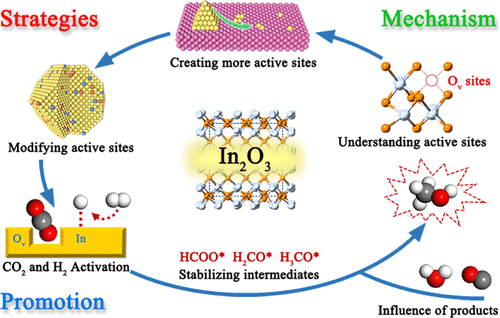当前位置:
X-MOL 学术
›
ACS Catal.
›
论文详情
Our official English website, www.x-mol.net, welcomes your
feedback! (Note: you will need to create a separate account there.)
CO2 Hydrogenation to Methanol over In2O3-Based Catalysts: From Mechanism to Catalyst Development
ACS Catalysis ( IF 11.3 ) Pub Date : 2021-01-14 , DOI: 10.1021/acscatal.0c03665 Jianyang Wang 1 , Guanghui Zhang 1 , Jie Zhu 1 , Xinbao Zhang 1 , Fanshu Ding 1 , Anfeng Zhang 1 , Xinwen Guo 1 , Chunshan Song 1, 2, 3
ACS Catalysis ( IF 11.3 ) Pub Date : 2021-01-14 , DOI: 10.1021/acscatal.0c03665 Jianyang Wang 1 , Guanghui Zhang 1 , Jie Zhu 1 , Xinbao Zhang 1 , Fanshu Ding 1 , Anfeng Zhang 1 , Xinwen Guo 1 , Chunshan Song 1, 2, 3
Affiliation

|
Carbon dioxide (CO2) hydrogenation to methanol with H2 produced with renewable energy represents a promising path for the effective utilization of a major anthropogenic greenhouse gas, in which catalysts play a key role for CO2 conversion and methanol selectivity. Although still under development, indium oxide (In2O3)-based catalysts have attracted great attention in recent years due to the excellent selectivity to methanol along with high activity for CO2 conversion. In this review, we discuss recent advances of In2O3-based catalysts for CO2 hydrogenation based on both experimental and computational studies. Various strategies have been adopted to improve the catalytic performance by facilitating the formation of surface oxygen vacancies (In2O3–x) as active sites, the activation of CO2 and H2 toward hydrogenation to methanol to mitigate reverse water–gas shift reaction, and the stabilization of the key intermediates. Mechanistic insights are gained from combining catalytic kinetic studies, in situ characterization, and theoretical investigations involving CO2 conversion via the formate HCOO* pathway versus the carboxyl COOH* pathway. Strategies to further promote selective CO2 hydrogenation to methanol include adding a metal component such as Pd or Ni on In2O3 (which may also involve formation of bimetallic In–M catalysts) to promote H2 activation and oxygen vacancy formation, combining In2O3 with an oxide promoter such as ZrO2 to enhance CO2 adsorption and activation, controlling the concentration of CO and H2O to enhance methanol formation, and adopting a second catalytic component to enhance CO2 conversion to other desired products such as olefins or aromatics on an acid catalyst such as zeolites. Through a comprehensive overview of the recent advances in In2O3-related catalysts, the present review paves the way for future development in In2O3-based selective catalysts for CO2 hydrogenation to methanol.
中文翻译:

基于2 O 3的催化剂上CO 2加氢制甲醇的机理:从机理到催化剂的开发
由可再生能源产生的H 2将二氧化碳(CO 2)加氢成甲醇,是有效利用主要人为温室气体的有前途的途径,其中催化剂在CO 2转化和甲醇选择性中起关键作用。尽管仍在开发中,基于氧化铟(In 2 O 3)的催化剂由于对甲醇的优异的选择性以及高的CO 2转化活性而近年来引起了极大的关注。在这篇综述中,我们讨论了基于In 2 O 3的CO 2催化剂的最新进展。基于实验和计算研究的氢化。通过促进形成表面氧空位(In 2 O 3– x)作为活性位点,将CO 2和H 2活化为加氢成甲醇的活化作用来减轻水煤气逆反应,已采取了各种策略来改善催化性能。,以及关键中间体的稳定化。通过结合催化动力学研究,原位表征和涉及通过甲酸HCOO *途径相对于羧基COOH *途径进行CO 2转化的理论研究获得了机械方面的见识。进一步促进选择性CO 2的策略氢化成甲醇包括在In 2 O 3上添加金属成分(例如Pd或Ni)(这可能还涉及双金属In-M催化剂的形成),以促进H 2活化和氧空位的形成,将In 2 O 3与氧化物促进剂结合例如ZrO 2以增强CO 2的吸附和活化,控制CO和H 2 O的浓度以增强甲醇的形成,并采用第二种催化组分以增强CO 2在酸催化剂上转化为其他所需产物,例如烯烃或芳烃例如沸石。通过全面概述In 2的最新进展O 3相关的催化剂,本综述为基于In 2 O 3的选择性催化剂的未来发展铺平了道路,该催化剂用于将CO 2加氢为甲醇。
更新日期:2021-02-05
中文翻译:

基于2 O 3的催化剂上CO 2加氢制甲醇的机理:从机理到催化剂的开发
由可再生能源产生的H 2将二氧化碳(CO 2)加氢成甲醇,是有效利用主要人为温室气体的有前途的途径,其中催化剂在CO 2转化和甲醇选择性中起关键作用。尽管仍在开发中,基于氧化铟(In 2 O 3)的催化剂由于对甲醇的优异的选择性以及高的CO 2转化活性而近年来引起了极大的关注。在这篇综述中,我们讨论了基于In 2 O 3的CO 2催化剂的最新进展。基于实验和计算研究的氢化。通过促进形成表面氧空位(In 2 O 3– x)作为活性位点,将CO 2和H 2活化为加氢成甲醇的活化作用来减轻水煤气逆反应,已采取了各种策略来改善催化性能。,以及关键中间体的稳定化。通过结合催化动力学研究,原位表征和涉及通过甲酸HCOO *途径相对于羧基COOH *途径进行CO 2转化的理论研究获得了机械方面的见识。进一步促进选择性CO 2的策略氢化成甲醇包括在In 2 O 3上添加金属成分(例如Pd或Ni)(这可能还涉及双金属In-M催化剂的形成),以促进H 2活化和氧空位的形成,将In 2 O 3与氧化物促进剂结合例如ZrO 2以增强CO 2的吸附和活化,控制CO和H 2 O的浓度以增强甲醇的形成,并采用第二种催化组分以增强CO 2在酸催化剂上转化为其他所需产物,例如烯烃或芳烃例如沸石。通过全面概述In 2的最新进展O 3相关的催化剂,本综述为基于In 2 O 3的选择性催化剂的未来发展铺平了道路,该催化剂用于将CO 2加氢为甲醇。

































 京公网安备 11010802027423号
京公网安备 11010802027423号